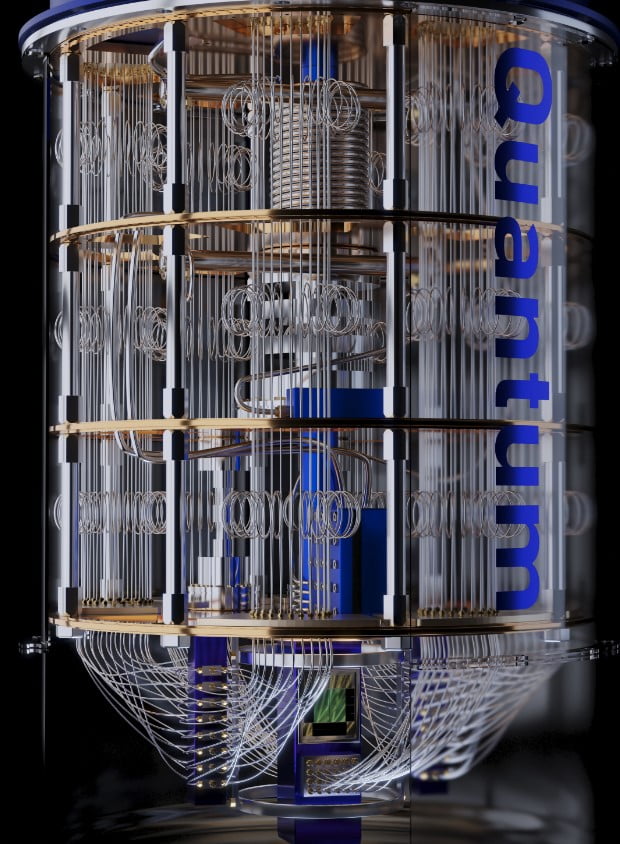Table of Contents
As researchers, physicists and engineers take bold steps to advance quantum computing (QC), we understand the form and shape the next-gen technology will take. Like today’s computers, quantum devices have to be connected over an ultrafast network to enable the users to communicate and share resources.

This is where the 5G/6G network comes in. As you know, 5G is the fifth generation of mobile networks, a global wireless standard developed after the advent of 1G, 2G, 3G and 4G networks. In 2019, the first 5G network became a reality.
The wireless technology is better described as an evolution and revolution in mobile network technology. When experts promoted the 5G technology, they disclosed that it could download feature-length movies in 5 seconds or less. What this means is that the wireless network was going to be much bigger, smarter and faster than its predecessor, 4G/LTE. In other words, 5G technology isn’t just another increment to its predecessor, but it offers a leap forward in wireless technology. 5G technology has three networking architectures: Low band, Midband and mmWave High Band 5G technology.
To build the 5G wireless technology, developers focused on enhancing its predecessor’s bandwidth, latency, connection density, and reliability. Since the deployment of the 5G wireless network started in 2020, it has delivered mass connectivity, ultra-reliability, and guaranteed low latency.
As we stand on the cusp of this new technological era, it is essential to point out that the 5G technology comes with its limitations. That’s chiefly because by 2030, 5G may not be able to sustain all aforementioned benefits, making way for the 6G wireless network. Once the 6G wireless network takes over, it provides global coverage, improved spectral, energy and cost efficiency, tamperproof security and high-level intelligence. To achieve the feat, 6G will heavily rely on quantum technology because of quantum advantage. Well, in this article, we will give you some insights into how quantum-5G/6G integration will play out.
Impact of Quantum Technology on 5G/6G Network

To better grasp the impact of quantum technology on 5G wireless technology, we can ask, “Does network performance depend on devices the network connects?” Well, quantum computing may not have a direct impact on the 5G technology. The reason is that while the former runs on standalone devices configured with the principle of quantum mechanics, the latter is an independent wireless network, which has its compatible devices. For now, telecom engineers are developing 5G/6G technology for connecting traditional computers. However, the symbiotic relationship between the two cutting-edge technologies will improve user experience in these ways:
Ultrafast data transfer
When the 5G/6G network connects quantum computers, there will be faster packet and data transfers. As we generate more and more data (big data), QC systems will speedily process and analyse it. With 5G’s high-speed data transfer capabilities, you can share resources much faster over the network, thereby reducing latency and increasing efficiency in ways traditional computers couldn’t have achieved it.
Quantum simulations
Although today’s computers are efficient for simulating and analysing data, QC systems will bring about quantum simulation, which means they will simulate and accommodate more data than classical devices. With 5G technology, it becomes easy to transfer such simulations in real-time, enhancing the research and development of various fields (such as healthcare, cryptography, material science, etc.)
Quantum-classical computing
In truth, it will take a while for individuals and organisations to get rid of their traditional computers. In short, tech pundits project that many organisations will only use quantum computers to perform tasks that today’s devices cannot. Therefore, there is a need for interoperability between quantum technology and conventional computing. Thankfully, some companies are already working on this hybrid model. So, when QC systems go commercial, 5G networks will help to facilitate seamless communication and resource sharing between the two computer generations.
Quantum machine learning (QML)
For quantum machine learning to be feasible, the 5G network (or its later versions) has to facilitate it. With the 5G network, users can achieve real-time data collection and transfer for QML applications, leading to ultrafast insights and predictions.
Security
As companies continue to roll out their QC systems, there are concerns that QC systems can undermine the cryptographic security of today’s computers and other digital devices. If this happens, it will lead to wanton losses. However, quantum engineers can integrate quantum encryption methods into 5G’s security features to enhance the wireless technology by creating difficult-to-hack encryption keys and improving data security.
Real-world Use Cases of 5G and Wireless Quantum Computing

Let’s review some companies that have fully embraced quantum technology and the 5G network
BT Group
Headquartered in London, BT Group is a British multinational telecommunication conglomerate with footprints in 180 countries. The company has the largest network of fixed-line, broadband and mobile services in the UK. Apart from providing telephone services, BT Group also provides TV subscription and IT services to its users in the UK and elsewhere in the world. It was established in 1912 and has several subsidiaries. BT Group is one of those telcos pioneering the development of quantum technology and 5G technology to enhance their service offerings.
The Group believes that the advent of 5G for private networks marks a new era of connected industry experiences. The telco noted that its drive to embrace the 5G technology will help organisations driving towards “the digital industry” take advantage of modern technologies such as augmented reality and virtual reality, machine learning, robotics and automation, and artificial intelligence. It also believes that the 5G private network is an essential foundation and enabler for innovative research and technological advancements. In its blog post, the telco argues that its 5G private network is a core component of a cohesive digital industry solution. It added that the 5G will enable businesses to capture and analyse massive business data from multiple sources and enhance business efficiency.
Furthermore, BT Group is working on an initiative to develop its quantum computing ecosystem. The telco says that quantum technology will transform the entire telco industry and society in general. It also disclosed that it has partnered with electronics giant Toshiba to launch the commercial trial of a quantum-secured metro network. The aim of the project, according to BT Group, is to determine how quantum technology can be beneficial to telecommunication services such as circuit switching, packet routing, signal processing, and antenna beam steering. It is worth noting that the 5G technology plays a big role in those telecommunication segments.
AT&T Inc.
Founded in 1885, American Telephone and Telegraph Company (AT&T) is an American multinational telecommunications holding company based in Texas. It is the largest wireless carrier in the United States. So far, the telco covers millions of people in the United States and has heavily invested in 5G technology. Its investment in 5G technology stems from the strong conviction that the new wireless telecommunication network has the potential to create new communication possibilities.
For now, AT&T deploys 5G technology to enhance real-time video chats, multidimensional entertainment and other services. AT&T has already deployed the technology across many communities in the US. At the time of writing, the telco has connected 20 American states to its 5G network, allowing select users to enjoy the speed, security, reliability and convenience the technology brings to their devices. Its mid-band 5G network covers 175 million people, while its lower-band 5G network connects 290 million users. According to reports, the company splashed $27.4 billion on its mid-band airwaves and $9.1 billion on a complementary mid-band spectrum in 2022.
For quantum computing, the telecom corporation is leaving no stone unturned in its resolve to cash in on the limitless opportunities that the innovative technology holds for the future. As a result, AT&T Foundry Innovation Centre has been working tirelessly to realise this goal. The Centre has joined the California Institute of Technology to form the Alliance for Quantum Technology (AQT). AQT has one core goal – to bring the industry, government and academia under one umbrella to facilitate quantum development, research and emerging practical applications.
With the INQNET (Intelligent Quantum Networks and Technology) initiative underway, the alliance hopes to focus on capacity and secure communications through future quantum networking technologies. The AT&T team already knows what to expect as it believes that its QC systems won’t have keyboards, mice or monitors. With its quantum networking, the telco will link quantum computers and devices together so the devices can communicate and share resources.

MasterCard Inc.
Since 1966, MasterCard Inc. has worked with financial institutions worldwide to process transactions initiated by the customers of these financial institutions. Hence, it is the world’s second-largest financial processing corporation. Its principal business is processing payments between banks of merchants and card-issuing financial institutions or credit units of the purchasers who use the MasterCard debit, credit or prepaid cards to perform transactions. Based in New York, MasterCard Inc. serves financial services providers worldwide.
MasterCard deployed the 5G technology to not only deliver ultrafast services but also lower latency and promote greater connectivity. All those contribute to the enhanced services its users enjoy today. In July 2021, MasterCard started testing the 5G technology at its R&D division, MasterCard Foundry. The global financial card issuer would move on to reach a deal with smartphone and wireless network Verizon, enabling Verizon 5G to be integrated into MasterCard’s retail technology solutions. With the strategic move, MasterCard can reduce hardware requirements for autonomous checkout in-stores and deliver faster transactions and new use cases for the 5G technology.
Furthermore, MasterCard has partnered with the leading quantum annealing company D-Wave Systems Inc. to leap into the future of financial services. The future-focused business initiative entails that the two partners will collaborate to research and develop quantum-hybrid applications in areas of consumer loyalty and rewards, cross-border settlements and fraud mitigation. With D-Wave quantum annealing and quantum hybrid solvers playing a pivotal role in the partnership, the new project will be connected through the LEAPTM quantum cloud services to provide real-time access to quantum applications that would be powered by the MasterCard network.
Takeaway

Aside from the three companies we have dissected above, several other companies have already embraced the 5G technology and are now working hard to develop 5G-compatible quantum computers.
Indeed, they are working on that initiative to enhance their operations, protect their businesses, satisfy their users, and increase their revenue. It is safe to conclude that many firms believe that quantum-5G integration will improve the way we learn, connect, communicate, and share ideas and resources. Hence, they are investing in those technologies. Keep in mind though that when quantum technology becomes ubiquitous, 5G may be outdated. At that time, the conversation will be how companies can use the two innovative technologies side by side.
Irrespective of the generation of wireless technology in vogue at the time, the relationships will somewhat be the same as those discussed earlier. The good thing is that tons of digital devices in use today were designed with 4G/LTE in mind, meaning that 5G-enabled devices will still exist in our homes and offices for a long time.
Simply put, 5G technology will gradually phase out its predecessors or 5G wireless network won’t replace 4G technology instantly. A 2022 report indicates that there were about 240 networks built on 5G technology around the world, covering about 35% of the global population.
However, analysts forecast that global 5G deployment will reach 85% by 2028. On the other hand, tech pundits think that 6G technology won’t be launched until 2030 or later because it is still undergoing research and development at the moment. Once again, whether we have the 5G or 6G technology when companies fully commercialise QC systems, those systems will deliver a much better experience to their users than what traditional computers ever would.
Therefore, seeing QC systems and 5G/6G wireless technology work hand in hand (not necessarily the impact of the former on the latter) is something we are excited about, so we all look forward to it with great enthusiasm.
